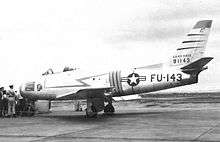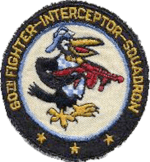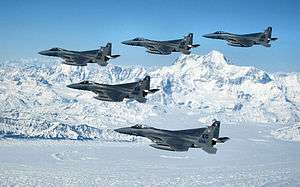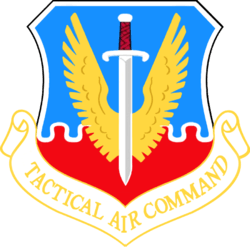60th Fighter Squadron
| 60th Fighter Squadron | |
|---|---|
|
Five 60th Fighter Squadron F-15Cs, from the 33rd Fighter Wing, Eglin Air Force Base, Fla., soar over the mountains ranges of Alaska during their overseas deployment to Elmendorf Air Force Base, Alaska, to participate in Red Flag Alaska 07-1 | |
| Active |
15 January 1941 – 8 December 1945 20 August 1946 – 30 April 1971 1 September 1971 – 1 January 2009 |
| Country |
|
| Branch |
|
| Nickname(s) | Fighting Crows |
| Engagements |
|
| Decorations |
|
| Commanders | |
| Notable commanders | Daniel James, Jr. |
| Insignia | |
| Emblem of the 60th Fighter Squadron |
 |
The 60th Fighter Squadron (60 FS) is an inactive United States Air Force squadron. It was last assigned to the 33d Fighter Wing at Eglin Air Force Base, Florida. It was inactivated on 1 January, 2009.
History
World War II
Activated in 1940 at Mitchel Field, New York as the 60th Pursuit Squadron, the unit was attached to the 33d Pursuit Group on 15 January 1941. Re-designated as the 60th Fighter Squadron "Fighting Crows" on 15 May 1942, the unit was responsible for the continual mission of air defense of the United States until October 1942. In late 1942, the 60th joined the United States' effort in World War II by participating in combat operations in the Mediterranean Theater and the China-Burma-India Theater. As a result of superior performance in central Tunisia, the 60th earned the Distinguished Unit Citation for combat operations on 15 January 1944. Following its service in World War II, the 60th was assigned to the 33d Fighter Group at Neubiberg Air Base, Germany in August 1946 and flew the P-51 Mustang.[1]
Air Defense Command


In 1947, the 60th transferred to Roswell, New Mexico and soon afterward, in June 1948, converted to the F-84 Thunderjet. In November 1948, the 60th transferred to Otis Air Force Base, Massachusetts and by June of the following year had completed a conversion to the new F-86 Sabre. On 9 August 1950, the 60th moved to Westover Air Force Base, Massachusetts and on 1 January 1951 became part of the Air Defense Command. From 1952-1959, the 60th, flying the F-86 Sabre and the F-94 Starfire was assigned to various organizations including, the 4707th Defense Wing, 4735th Air Defense Group and the Boston Air Defense Sector all located at Otis Air Force Base.[1]
On 5 January 1959, the 60th was the first Air Defense squadron to receive the new McDonnell F-101B Voodoo interceptor. The unit was additionally tasked as part of the joint test force (teamed with members at Eglin Air Force Base, Florida) to test the F-101's operational capabilities prior to its entrance into active service. The F-101B proved to be a quite successful interceptor. assigned alongside the F-101B interceptor was the F-101F operational and conversion trainer. The two-seat trainer version was equipped with dual controls, but carried the same armament as the F-101B and were fully combat-capable.[1]
During the 1960s the 60th participated in various tests, exercises, and operations in the Air Defense Command. In October and November 1962, the unit was placed on alert during the Cuban Missile Crisis, but was never deployed. Although it has been stated that F-101B Voodoos from the 60th were used in the production of the 1966 comedy The Russians Are Coming, the Russians Are Coming, the film, although set in New England, was shot on the West Coast for financial reasons and the fighters were from the 84th Fighter-Interceptor Squadron, based at Hamilton AFB, California.[2] The 60th inactivated on 30 April 1971.
Tactical Air Command
In September 1971 the squadron was reactivated at Eglin Air Force Base as the 60th Tactical Fighter Squadron. In 1979 the unit participated in the "Kadena Ready Eagle" program in which the members of the 60th trained new F-15 pilots stationed at Kadena Air Base, Japan.[1]
The 60th made its first combat deployment since World War II when it sent ten F-15s to Grenada in support of Operation Urgent Fury, the rescue of American medical students held in Grenada in the mid-1980s. The unit continued to train and until it was called upon to fly support missions for Operation Just Cause (the removal of Panamanian dictator Manuel Noriega from Panama in the early 1990s).[1]
Modern era
The 60th Fighter Squadron flew the F-15 Eagle and supported the various combatant commanders by providing air superiority on call. It flew its last F-15 mission on 5 December 2008.
The squadron was inactivated on 1 January 2009.[1]
Lineage

- Constituted 60th Pursuit Squadron (Interceptor) on 20 Nov 1940
- Activated on 15 Jan 1941
- Re-designated: 60th Fighter Squadron on 15 May 1942
- Re-designated: 60th Fighter Squadron, Two Engine, on 8 Feb 1945
- Inactivated on 8 Dec 1945
- Re-designated 60th Fighter Squadron, Single Engine, on 17 Jul 1946
- Activated on 20 Aug 1946
- Re-designated: 60th Fighter Squadron, Jet, on 14 Jun 1948
- Re-designated: 60th Fighter-Interceptor Squadron on 20 Jan 1950
- Inactivated on 30 Apr 1971
- Re-designated 60th Tactical Fighter Squadron on 18 May 1971
- Activated on 1 Sep 1971
- Re-designated: 60th Fighter Squadron on 1 Nov 1991
- Inactivated on 1 January 2009[3]
Assignments
- 33d Pursuit (later, 33d Fighter) Group, 15 Jan 1941 – 8 Dec 1945
- 33d Fighter (later, 33d Fighter-Interceptor) Group, 20 Aug 1946
- 4707th Defense (later, 4707th Air Defense) Wing, 6 Feb 1952
- 33d Fighter Group, 18 Aug 1955
- 4735th Air Defense Group, 18 Aug 1957
- Boston Air Defense Sector, 1 Aug 1959
- 35th Air Division, 1 Apr 1966
- 21st Air Division, 19 Nov 1969 – 30 Apr 1971
- 33d Tactical Fighter (later, 33d Fighter) Wing, 1 Sep 1971
- 33d Operations Group, 1 Dec 1991 – 1 January 2009[3]
Stations
Aircraft
|
|
References
![]() This article incorporates public domain material from the Air Force Historical Research Agency website http://www.afhra.af.mil/.
This article incorporates public domain material from the Air Force Historical Research Agency website http://www.afhra.af.mil/.
- 1 2 3 4 5 6 60 FS Fact Sheet
- ↑ "Overview for The Russians are Coming, the Russians are coming". Turner Classic Movies. Retrieved: 1 January 2009
- 1 2 3 4 AFHRA 60 FS Page
- A Handbook of Aerospace Defense Organization 1946 - 1980, by Lloyd H. Cornett and Mildred W. Johnson, Office of History, Aerospace Defense Center, Peterson Air Force Base, Colorado
- USAF Aerospace Defense Command publication, The Interceptor, January 1979 (Volume 21, Number 1).
- USAF 60th Fighter Squadron History
- 60th Fighter Squadron Fact Sheet




.svg.png)
.jpg)